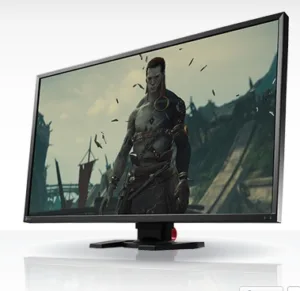Eizo has announced a new monitor in its ‘Foris’ gaming series. As a model aimed at gamers, the 27″ FS2735 features a high (144Hz) refresh rate, IPS panel and AMD’s Freesync anti-tearing solution.
G-Ignition is Eizo’s monitor setting adjustment software. In the FS2735, Eizo has introduced two new versions of the software called G-Ignition Mobile and G-Ignition Drive. The former is an iOS- and Android-compatible application, working with the Bluetooth connectivity built into the monitor; gamers are able to use their mobile devices to adjust the colour, brightness, gamma and other settings. G-Ignition Mobile is also able to post a notification in the corner of the screen when a call or message arrives on their smartphone.
G-Ignition Drive is Eizo’s own cloud service, which gamers can use to upload their settings to share their presets with other users. Both G-Ignition Mobile and legacy G-Ignition software can be used to access G-Ignition Drive.
Like Eizo’s FS2434, the FS2735 features ‘Smart Insight’ and ‘Smart Resolution’ technologies. Smart Insight identifies and lightens dark areas of an image to improve in-game visibility. The feature has been improved on the new display, and is known as Smart Insight Demolition; this function also identifies areas that are too bright, and adjusts them to enhance contrast.
Smart Resolution evaluates an image and corrects blur without accentuating the noise. AMD’s Freesync technology also helps to improve image quality by eliminating stutter and tearing.
As well as a Game mode, the FS2735 has Cinema, Paper, sRGB and user-adjustable settings. An ergonomic stand provides 155mm of height adjustment, -5° – 35° tilt and 180° swivel. Two 1W speakers are built in.
DisplayPort, HDMI (x2), DVI-D, USB 3.0 (x2) and USB-B inputs are built in. The monitor has 2560 x 1440 resolution. More specifications will be shared closer to its release date this winter.
Analyst Comment
This is the first monitor that we have seen that includes Bluetooth connectivity for adjustment. Historically, it has always been a challenge for monitor makers to develop good OSDs for control using just a few switches or controls on the monitor and with limited processing power. Of course, VESA developed a control system for allowing monitor adjustment from a PC, but using Bluetooth and a handheld device also has some merit. Of course, adding Bluetooth might be OK on a premium product such as the FS2735, but the cost adder would be difficult on cheaper monitors. However, if the Bluetooth was integrated into the monitor controller, the cost adder might be very low. (BR)

